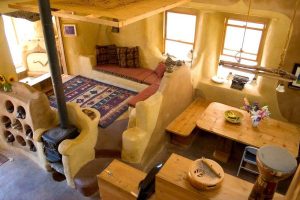There have been some developments in the planning system that might allow a lot more people to build their own home. First, here’s some background.
After 2008, most large building companies were wiped out, leaving just 10 huge, volume builders in the country, building around 150,000 homes between them per year, at inflated prices. On top of this figure, around 20,000 homes are built by some local authorities and housing associations, plus around 10-14,000 self-builds. The UK is way behind the rest of Europe when it comes to self-build.
The government say that we need to be building 300,000 homes per year, but can’t persuade volume builders to build that many, as prices would fall; and local authorities and housing associations don’t have the capacity. So there’s huge potential for self-build to fill the gap. According to an IPSOS MORI poll in 2015, 26 million people would like to build their own home at some point.
In 2014, Richard Bacon, MP and self-appointed ‘self-build czar’ submitted a private member’s bill to assist self-builders. It became law in 2015, and since October 2016, every local authority in the country has been obliged to keep a register of people who would like to self-build in their area, and to advertise that register to the public.
The local authorities are then obliged to reflect the demand revealed by the register by approving the equivalent number of serviced plots. This is a rolling programme of 3-year tranches, and the first 3-year period is just ending. Here’s Daniel Scharf, member of the Royal Town Planning Institute, explains what’s happened, and what you can do if you’d like to build your own home.
Over to Daniel (who can answer any queries you might have in the comments):
The Government is keen to see the level of self- and custom- built homes grow from a measly 8% per year in the UK to something that compares with other countries (eg >50% in Austria). It’s also aware that the current housebuilding industry (ie ten large housebuilders with a small contribution from councils and housing associations) does not have the capacity to build the 300,000 dwellings deemed necessary.
The evidence for the need for that amount of new building is actually contestable, and it’s unlikely that building new houses at that scale can be achieved within carbon budgets without a sea-change in building techniques and materials.
So, to incentivise self/custom building, there is legislation in place (the Self-build and Custom Housebuilding Act 2015 as amended) that requires planning authorities to advertise and maintain a register of those who would like to build in their area, and to provide enough serviced plots to satisfy demand shown by the register.
The law also states that people on the registers should not have to wait more than three years for an opportunity to arise. As the first tranche of self/custom builders joined the register before October 2016, the first tests of whether planning authorities have fulfilled their duty are emerging now.
[The first publicised test is set out in the appeal decision letter https://acp.planninginspectorate.gov.uk/ViewDocument.aspx?fileid=33019573. This decision shows that planning authorities cannot rely on any permission that has not been specifically limited or reserved by planning obligation for use by self/custom builders. Landscape considerations can be taken into account
but this decision shows that the lack of serviced plots to meet the registered demand can be a material consideration to override the local plan policies or other potential objections.]
Planning authorities can be expected to respond to this decision by reserving significant areas of the larger sites being allocated and permitted for self/custom building, or even allocating sites specifically for this purpose. Meanwhile, the absence of an adequate supply is an invitation for self/custom builders (especially those already on the registers) to find suitable sites and submit planning applications based on the fact that the planning authority is failing in its legal duty.
This appeal decision might also encourage more people to register, as the prospects of finding a serviced plot will increase through both the more proactive approach taken by councils, and other successful applications and appeals like the above case in Swadlincote. Councils will be aware of their failure to make adequate provision and might even start to grant permissions without the need and expense (to all parties) of appeals, so long as the site has been carefully chosen to avoid any of the most serious objections eg dangerous access, contaminated land, flood zones, SSSIs. Areas of Outstanding Beauty and Green Belts are also likely to be hard nuts to crack, but the failure of the council to meet the registered demand might be seen as ‘exceptional circumstances’ to grant permission. The argument for allowing self-building as an overriding material consideration would be more powerful at application and appeal if the application is for a significant number of self-building opportunities.
 About the author
About the author
Daniel Scharf is a member of the Royal Town Planning Institute and for over 40 years has provided advice on land use planning in the public, private and voluntary sectors. Daniel’s ideas for regenerating local food systems and providing affordable housing through planning at national, local and neighbourhood levels are developed on his blog. He’s also our specialist on planning permission.








4 Comments
Hi iam derek I have a registered small holding I have built up over 81/2 years from just a field,we have alpaca’s we breed and do walking with ,also goats for breeding and for meat,along with chickens ,ducks ,geese ,peacock’s for egg’s and breeding we had to get full planning for our barn , we got that and a toilet and shop we are building our barn at the moment we also have had a camp site up and running the past 2years we have had over 50 booking’s this year ,we have11 acres,and we how need to be there full time but we need to live there could we get planning we want to put more in to it but it is hard living 9mile’s away I will not give up ,iam finding it hard with the local planning and thay lie as I found out we had to deal with a enforcement were thay said we did not have any animals in there statement of the appeal witch we won thank god , can you help
Derek
Your post does not make it clear what you have failed to get permission for (ie a reference to an appeal being allowed), but I assume that it is a permanent dwelling. I am afraid that I can’t give specific advice without knowing all the details of the case including your operations and the planning history. This is not the work that I currently do as I concentrate on the area of policy rather than individual cases. I can say that it is confirmed that LPAs now find themselves in a position that the failure to provide a number of serviced plots commensurate to the demand shown by the statutory registers could be a material consideration sufficient to overcome policy and landscape objections. As you probably know the other considerations will be the viability of the holding (with some allowance made for low impact living) and the need to live on the holding (that I suspect you could demonstrate).
Thank you for this very interesting article. It is encouraging to see this new attitude of planning agencies with regards to self-build. I really like your suggestion for prospective self-builders to be pro- active and make
applications based on the fact that the planning authority is failing in its duty. I was wondering. Would there be a way for us to actually check whether our local planning authority is indeed failing in its duty? I understand the self-builder register is publicly available but how would I know if the council has addressed the demand accordingly or not?
Thank you, Vincent
I can see no reason why a Council should not say how many people are on the register (in each year) and how many serviced plots reserved for self/custom building have been permitted (in each year). The case cited in the original blog might have to be drawn to the council’s attention so that it understands that only serviced plots reserved for self/custom builders count.